
Well, this was sure to be a trip unlike any other before, and any other to come! Take a glimpse into one of the most unpredictable, feared and fascinating places on Earth.
This is the largest component of my November 2015 trip:
- Singapore Airlines Premium Economy (Sydney – Singapore)
- Singapore Airlines Economy (Singapore – Beijing)
- Hilton Wangfujing, Beijing
- Air Koryo Economy (Beijing – Pyongyang)
- Koryo Hotel, Pyongyang
- Hyangsan Hotel, North Pyongyang
- Tour of North Korea
- Air China Economy (Pyongyang – Beijing)
- Raffles Beijing
- Hong Kong Airlines Economy (Beijing – Hong Kong)
- Singapore Airlines Economy (Hong Kong – Singapore)
- Singapore Airlines Premium Economy (Singapore – Sydney)
Also take a look at our guide to travelling to the DPRK.
Note: These pictures may take some time to load, as they are large files and there are many of them. You won’t be disappointed, though!
Day 1
Seated at the gate in Beijing Capital International Airport, it seemed to be a normal crowd of people waiting to board a normal flight. But when looking closer, it could be noticed that a significant majority of the middle-aged Asian men dotted throughout the gate all wore big red lapel pins, adorning the glorified faces of President Kim Il Sung and General Kim Jong Il. They carry worn and dated black passports, with golden cover writing, presumably noting “Democratic People’s Republic of Korea Travel Document”. How few must be in existence…
As opposed to a normal flight, there were no boarding calls for this Air Koryo journey to to Pyongyang. Following private boarding for about four Russian diplomats, the herd of North Korean officials, Chinese tourists, and us began to board, a process that was much faster than Western airlines. I’ll leave out the details of the Air Koryo flight, as they can be viewed in a separate report here.
Final approach to Pyongyang was nothing to be excited about. There were endless fields for farming, mostly barren and brown. Patches of greenery, adorned by grass or Korean cabbage brightened up the lands just a bit. A light brown haze or smog was visible, lying low to the ground, making for an eerie approach.

Following a smooth touchdown, we disembarked through a brand new, glass airbridge into a phenomenally glossy and shiny Sunan International Airport, just in time to see the sun dip behind the mountains. Immigration was a breeze, baggage control at a snail’s pace, and customs a crazy nightmare, involving a North Korean guard scrutinising the contents of my laptop.
The airport itself was actually quite a sight. The shiny floors had been repeatedly polished so they appeared mirror-like, whilst providing a perfectly slippery surface. The luggage trolleys were new and fluid, and by this point I had firmly decided that Pyongyang International is worlds ahead of Sydney, and many others!
Following immigration, we met our local North Korean guides, two ladies, who would be our chaperones for the week. We were also introduced to our driver, Jong Dong Ji (meaning ‘Comrade Jong’) and boarded an old mini-van adorned with the logos of the “Korea International Travel Company (KITC)” (This is said to be a safeguard in the event of any invasion or terrorist attacks). The guides were incredibly friendly, and named Kim and Jung.

After a short drive, we arrived in Pyongyang city, where the first stop was the “Arc of Triumph”. It was surprisingly similar to the one in Paris, yet our guides were adamant about the fact that it was “10m higher that the Paris one”!
It was also our first glimpse at the city, and upon first look, it appeared to be a normal, albeit slightly quiet, Asian city. Vehicles were not as uncommon as we thought, and there was light activity on the roadside. What did stand out, however, were the countless enormous murals and photographs featuring President Kim Il Sung, General Kim Jong Il and Marshal Kim Jong Un (the latter is less common, as he is still alive).
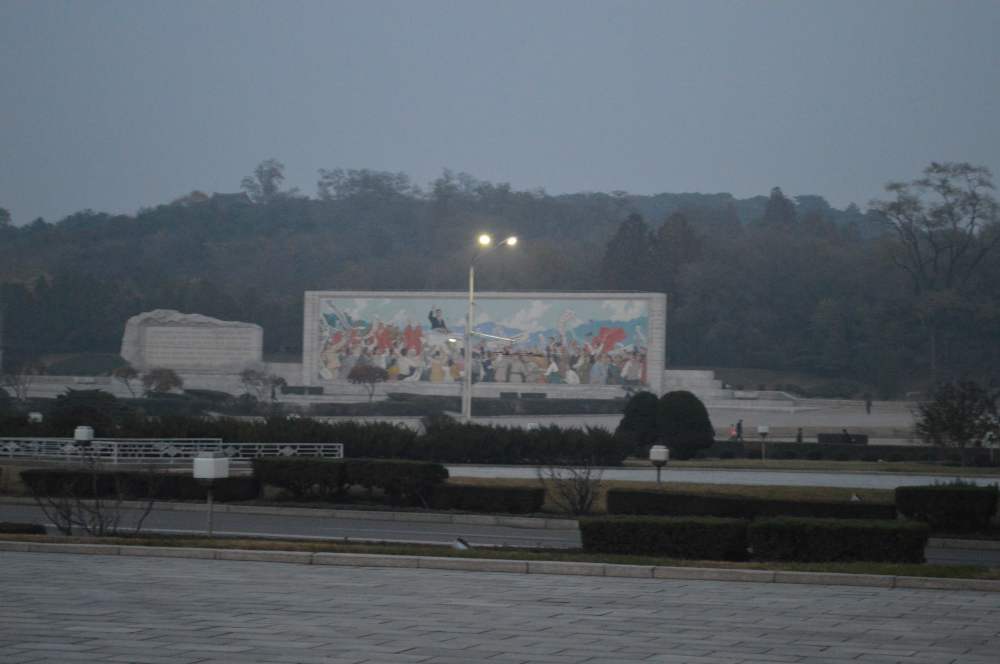


As it was evening, we were taken to a KITC restaurant, where we had our first encounter with North Korean cuisine. The place was empty, and as we walked up the waitresses were singing karaoke. As soon as they saw us, they hurriedly stopped and took their positions. There was one table set with 5 places (for the two of us, as well as the two guides and Comrade Jong), but apart from that the place was completely empty. The meal commenced, and featured a traditional Korean hot-pot. In all honesty, it was far less than average, in terms of taste. I was also given a bottle of water, which I noticed had not been properly sealed… Dinner also consisted of a briefing of the tour, and focused on 4 ‘tourist rules’ that “every country has”: DO NOT leave the hotel; DO NOT take photos of military; DO NOT take photos of anything without asking; DO NOT practice or publicise any form of religion.

We then made our way to the Pyongyang Koryo Hotel, where we were able to witness Pyongyang by night along the route. There were some moderately disturbing sights. Trams seemed to be a very common mode of transport, yet were unbelievably old, and appeared to have not been altered since the 1970’s. They were all absolutely packed with people to a very discomforting level. We passed a strange point where a huge line of people stood on the roadside, luggage and suitcases in hand, waiting still and patiently for a bus to who knows where… All in the dark, cold night.
Kim, our guide, also pointed out some ‘new dwellings’ where people were living. They had decorative lights on on the exterior, yet no interior room lights were on… Hmm.
There were a great deal of new-looking taxis, which was a surprise, as we were unsure who used them.. military only, perhaps? There were also very old German cars from the 1960’s, as well as some brand new Audi’s and Mercedes’.

We arrived at the Koryo Hotel, whose details I will leave in this report.
The start to our adventure was somewhat shaky and worrying, and we could hardly believe that we were actually inside the Democratic People’s Republic of Korea.
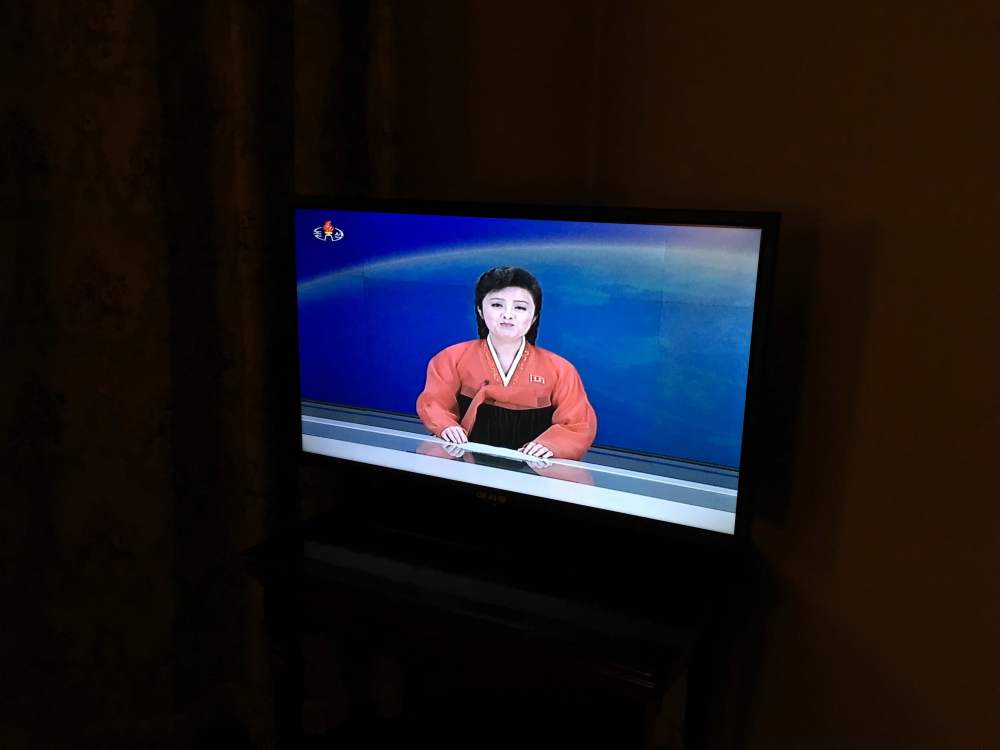
Day 2
Well, this Wednesday was our first full day in the glorious DPRK. After a pretty solid sleep, we were awoken by our guides through a ‘morning call’ (wake-up call), got changed and headed to breakfast in the hotel.
Breakfast was our first glimpse into the true shortcomings in the nation. While waiting for the elevator, the hotel’s power cut out, leaving us in an ominous pitch black lobby for about a minute, before it came on again. The restaurant was set up with an attempt to be glamorous, and was almost empty of people. As it has been for all the previous restaurants we have visited, our table was already set. Breakfast was supposed to be a ‘buffet’, however consisted of no more than: a choice of apple or strawberry soft drinks (which was sweet at an ungodly level); about 10 thin apple slices; a basket of bread and toast; a plate of a dozen or so almonds and pistachios; and a chef cooking fried eggs. So after exhausting the selection (with only 1 egg), the ‘waiter’ brought us a dish with two tiny pieces of cheese, that wouldn’t even be touched by a mouse. We finished up quickly (because there was nothing to eat) and headed down for the tour.

What really struck me here is that a real shortage of food actually exists in the DPRK. The buffet was depressingly bare, and a nearby fridge seemed as though it had been half empty for weeks. It’s no wonder the waiter said not to take photos…
We boarded our KITC minibus – whose interior smelt strongly of petroleum – and headed to the Mansude Fountain Park. We were requested to purchase a bunch of flowers for 5 Euros each, to be used later on.
It’s worth noting the details of currency in the DPRK. Tourists are not permitted to hold or use the new North Koran currency (the Won). Instead, they are only to use Euros, US Dollars or Chinese Yuan-Remnimbi. We found that the exchange rates were very dodgy, and depending on the location of the purchase, it may have been far more worthwhile to use either EUR, USD or CNY. They were not all equal.
The ‘Fountain Park’ consisted of barren and dry pools, with plumbing and pumps plainly visible. Kim said that it was not switched on because it “was too early in the morning”… In reality it appeared to have not been used for months.
Mansude Fountain Park:




Following a very boring start, we drove to Kim Il Sung square: the wide and vast paved area that is often used for parades and performances, as seen on international TV. Groups of young-looking North Koreans crowded the edges of the square, carrying big bags and other luggage-like objects. This seems to be a common factor among a lot of the people we see on the streets… Are they homeless? Continually moving? Who knows. Being in the centre of the square, nonetheless, was overwhelming, due to the unbelievable scale.
Area surrounding Kim Il Sung Square:




We walked the streets of Pyongyang up to a souvenir shop, which like everything else seemed only to ‘switch on’ whenever a tour group walked in. It featured a vast array of books, most of which were translations of the speeches of the great leaders. Hand-painted posters were also on offer for a ridiculous 56 Euros each.
The streets of Pyongyang:


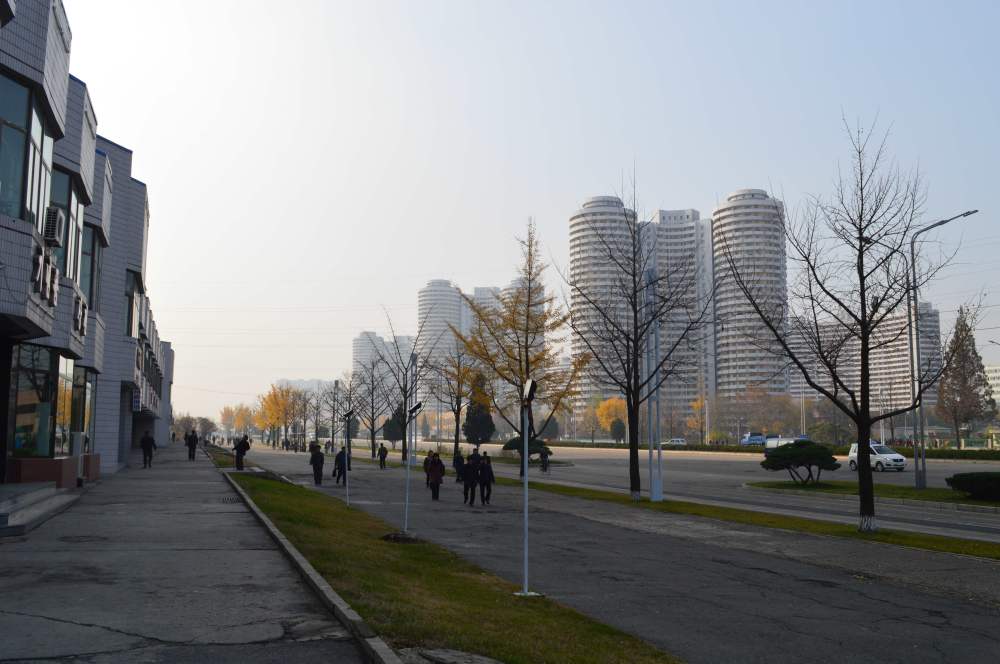

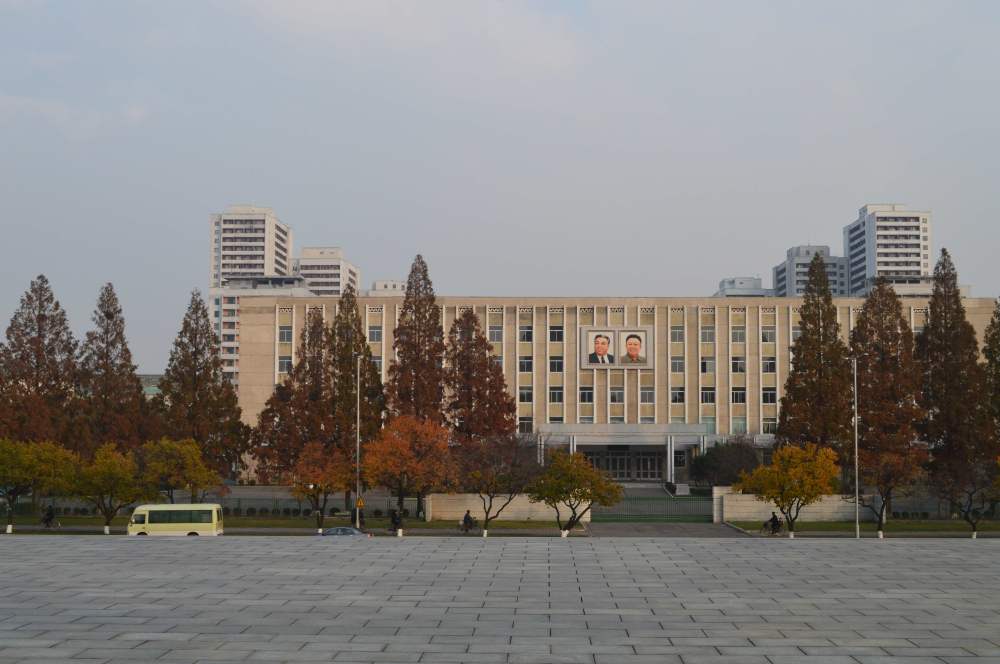
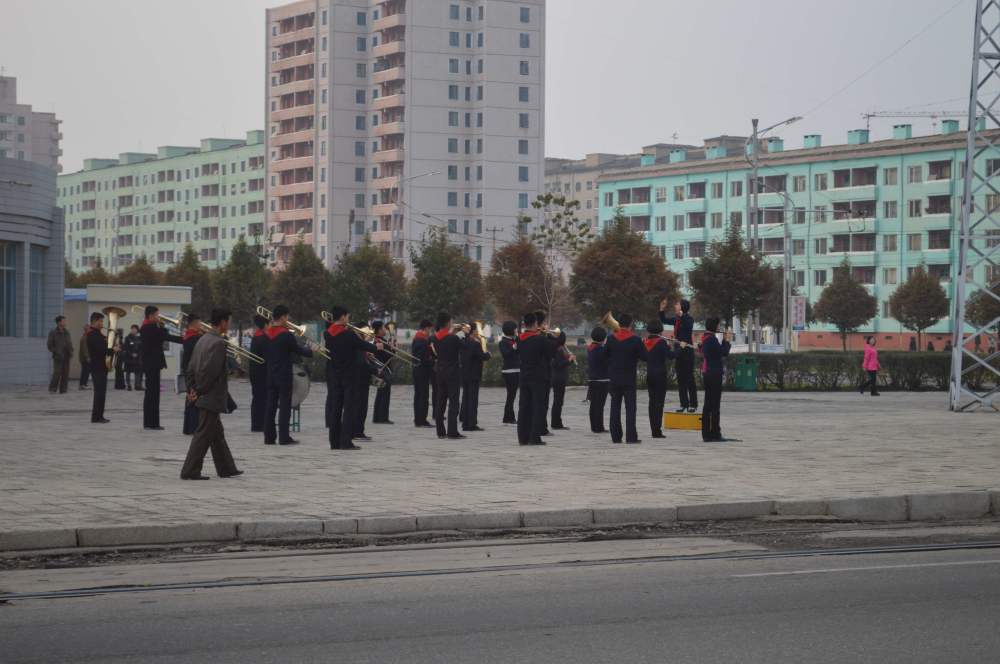





After spending a great deal of time ensuring we purchased everything possible and spending a significant amount of money, we walked to the People’s Study Hall, otherwise known as a library.
This building seemed grand from the exterior, yet appeared to be a 1950’s hospital inside. The walls and floors were coloured with dull, old greens and greys, and the dim fluorescent lighting created eerie looking hallways and corridors. We were also told there are over 30 million books in the library (yeah, right…), 60% of which are in a foreign language. One of the several hundred rooms, the ‘Music Appreciate Centre’ consisted of age-old CRT TVs and boom boxes, playing North Korean pop music. Just looking at the tables, degraded chairs and the ancient technology, it was yet another reminder that this country hasn’t moved since the ’50s. This was affirmed more when we passed the 60 year old fire extinguishers, styled like we’ve never seen them before.
Grand people’s study house:
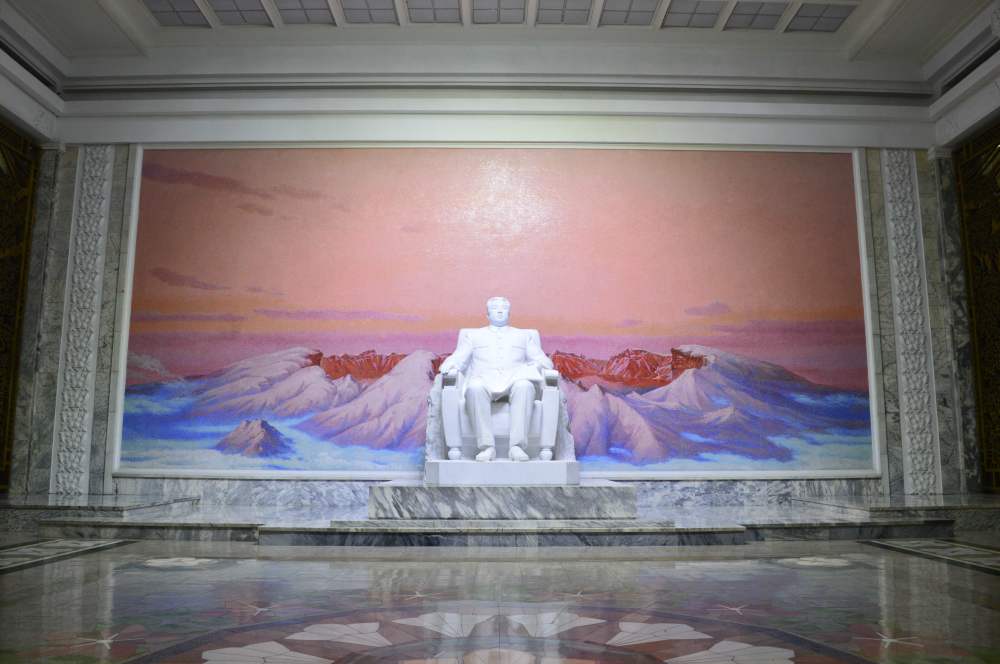
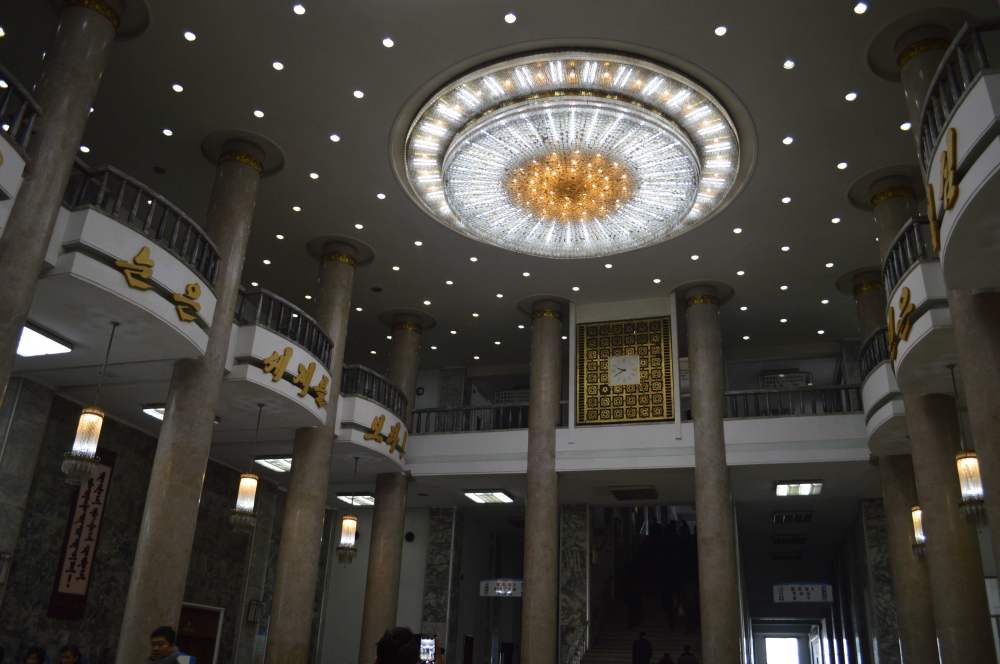





The next stop was the memorial statues of President Kim Il Sung and General Kim Jong Il. As we approached the grand square, we came up to a wedding couple, and ended up having photos with them, taken by many of the wedding party. The square itself was enormous, with the statues towering to the sky, resembling gods. We were told to place flowers at a bench, and then bow to the leaders. It is unbelievable how spotless the area is. It is as if half the population is employed just to maintain these monuments in an ‘as-new’ fashion.
Kim Il Sung and Kim Jong Il Brass Monuments:





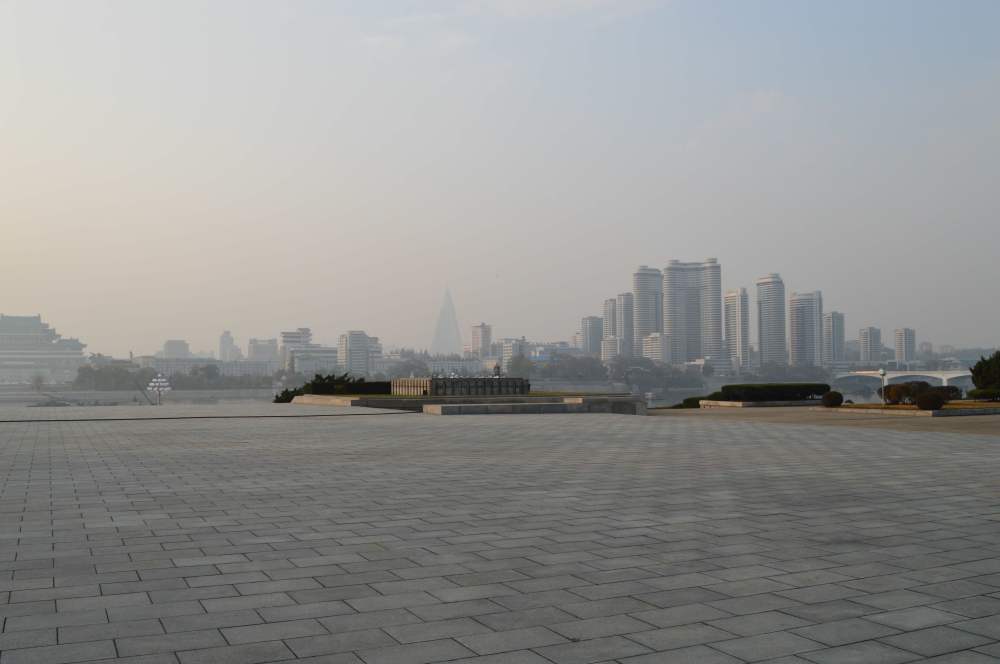

Yet another flaw then became apparent. The country seems to use a significant majority of their manpower and money to build and maintain war and leadership monuments. As we later saw, they are unbelievably opulent and grand, whilst more fundamental things like transport and the library are given far less thought and attention. All they’re concerned about is displaying how ‘great’ their ideologies are, how ‘glorious’ their leaders are, and how ‘valiantly’ they fought in the Korean War.
After a quick visit to the ‘Art Gallery’ (which resembled the old and drab Study Hall), we headed to the War Museum. They are incredibly adamant on showing how the ‘US Imperialists’ (a phrase they used all too often) provoked the war, and did everything wrong, whilst the North Koreans simply defended their territory. Yes, this may or may not be true, I’m no historian, but the lengths they go to to prove their perfection is ridiculous and simply disgusting. We also visited the USS Pueblo, a captured US Navy vessel that originally claimed to be doing ocean research in the area. The North Koreans took hold of it after they realised the ship was conducting illegal espionage. As the war never actually ended, the Pueblo is still a commissioned vessel, part of the US Navy, and is the only commissioned US vessel to be held captive by an enemy. The museum very, very proudly displays and flaunts this ship, as well as an array of bombs, guns, tanks and broken aircraft, all captured from enemies such as the UK and US.
Korean War Museum:




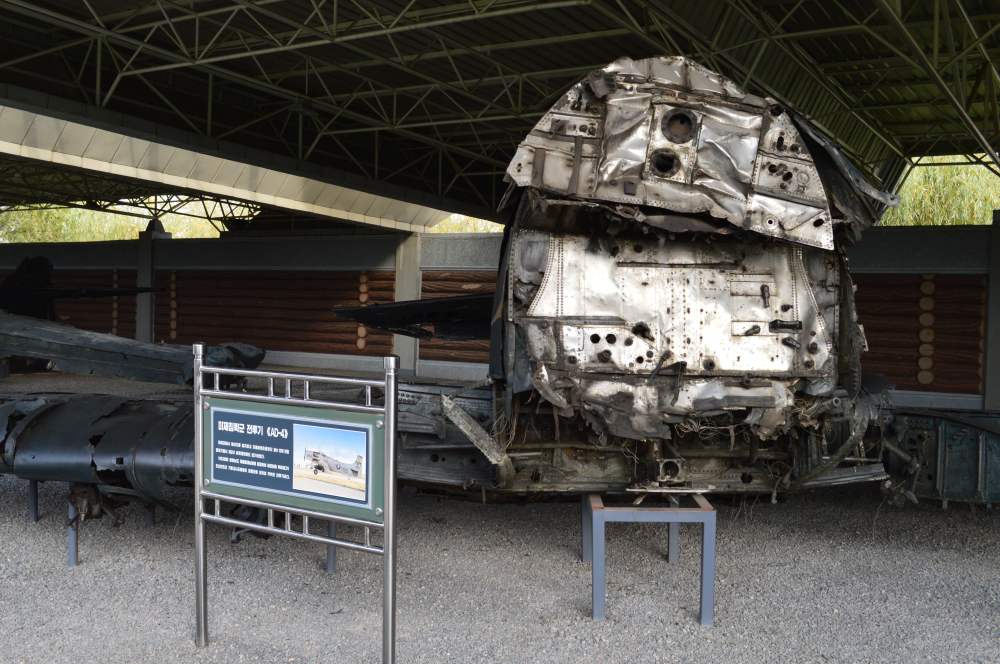
Next up was a highlight… the Pyongyang Metro! The station surface was super dodgy, with barely any ticket barriers. There was simply a staff member standing next to a dispenser that people would drop a couple of coins into. The journey consisted of an extraordinarily long escalator ride about 100m below the surface. Honestly, this envied the likes of the Hong Kong MTR and the London Underground. The underground stations were gorgeous, and featured high, arched ceilings and opulent lighting. These stations (also accompanied by continuous soothing music) are far nicer than the ones in the Sydney Trains network! The metro efficiency is also astounding, with timely and frequent services. The trains themselves are another story, however. They appeared to have been made in 1950, and haven’t been touched since. Many are old East-German carriages, complete with German graffiti. The doors open manually, and close ‘automatically’ through a rough spring loaded mechanism. The interiors were drab and old, smelled like human waste and featured framed images of Kim Il Sung and Kim Jong Il at the ceilings.
Pyongyang Metro:


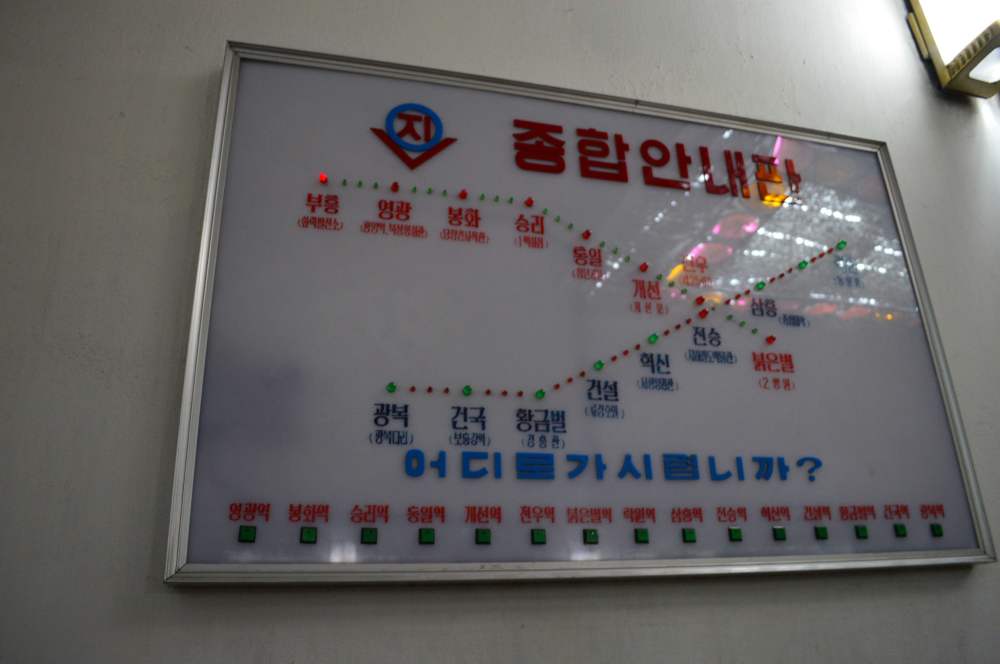





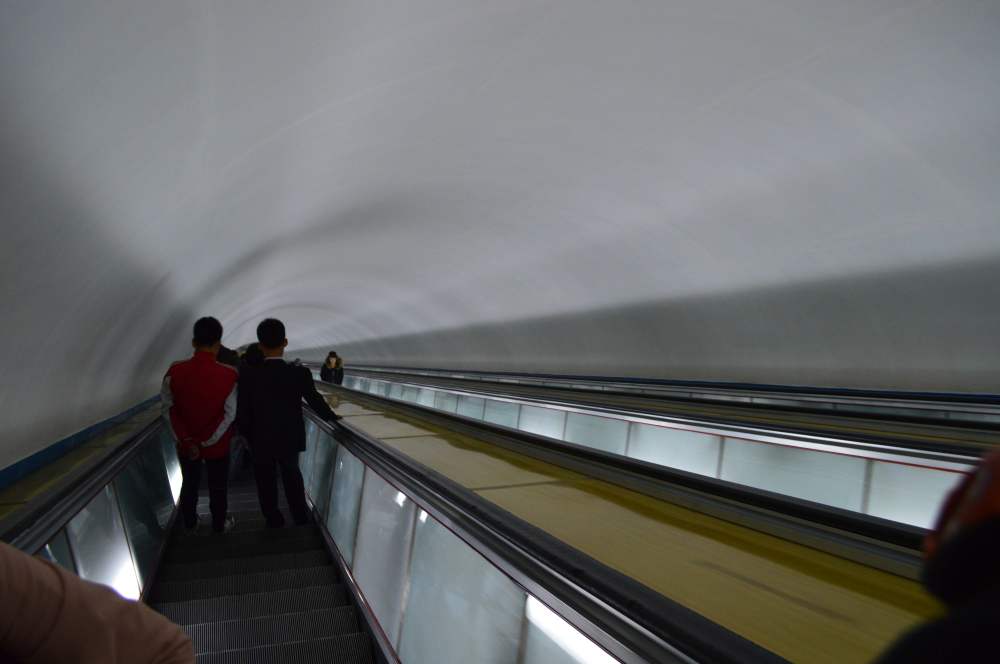
We then made our way to the Juche Tower, a 170m tall monument built for the 70th birthday of President Kim Il Sung. We were told about the many details and meanings, including the 70 inscribed flowers and 70 tiers, to symbolise his age. The guides are very clear about all the monuments having specific features and numbers to symbolise various things about their leaders. In all honesty, I find it a ridiculous waste of time and effort, and it’s yet another thing reminiscent of the nation being a cult-like society.
Juche Tower Area:






After a trip to the top of the tower to see Pyongyang from a magnificent angle, we made a quick stop at the Party Monument, which grandly displayed a hammer, sickle and paintbrush (representing the workers, farmers and intellectuals, respectively). This adds another dimension to the traditional socialist “hammer and sickle”, and is a symbol proudly displayed on flags, the local currency and in many stone statues around the city.
Part Monument:


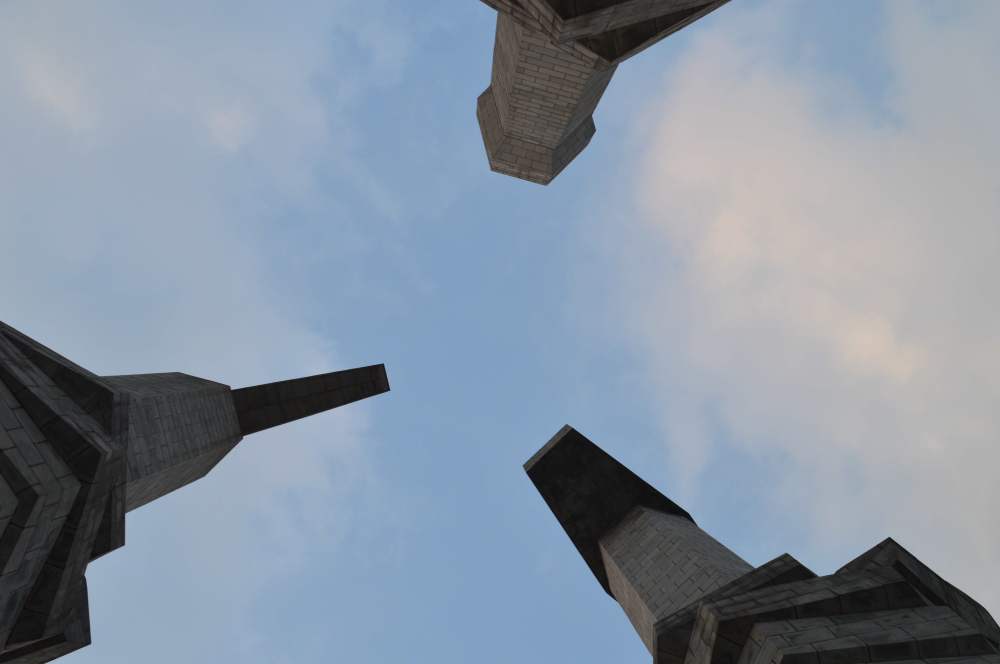
As we finished up early, we headed to the ‘7 Colours Beer Bar’, for a drink with the guides. The 7 colours, involved different brews and flavours, and we opted for the supposedly ‘chocolate’ spin. It was tasty, albeit strong, the common factor among North Korean brews. The bar itself was rustic and wooden, yet was completely empty apart from us and the waitress.
Rainbow Beer Bar:


The day finished up with dinner at the Pyongyang Duck restaurant, where we experienced another 2-3 power outages. Food was actually good, but not filling at all.
Day 3



The morning began with breakfast exactly like the morning before, and was very limited. On our way down, we ran into 3 Russian Military generals, dressed in full military suits. One was surprisingly friendly and greeted us as they entered the elevator. We later came to realise that the city is full of Russians on all sorts of business. The close geographical proximity and relatively similar ideals (especially from the Soviet Union days) make the two countries excellent friends. At the restaurant, we also ran into a lovely British lady who was “here for training” (we didn’t ask what training). It was great to finally speak to another non-North Korean in the country!
Today involved the scary, yet much anticipated trip down south to the De-Militiarised Zone (DMZ), the high-tension border between the North and South. The drive took over 2 hours, and took us along sparse, empty and wide highways along the countryside. The roads were so poorly built, and were covered in waves, ditches, debris and potholes, making for a bone-rattling 2 hour trip. Is it that hard to make a road?!!
Driving through North Korea:

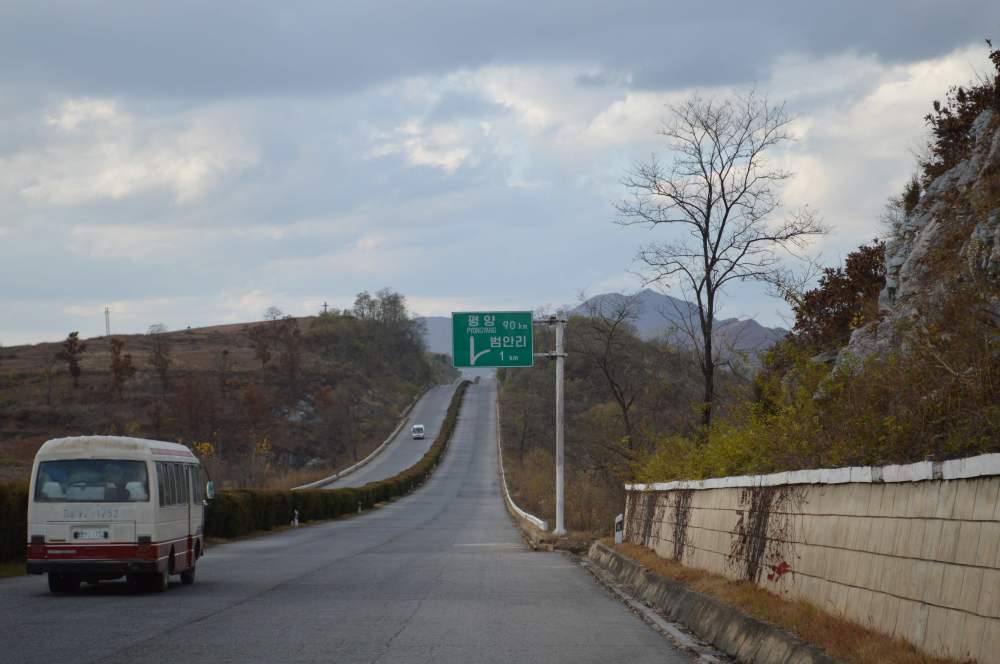




We also seemed to be one of the very, very few cars on the highway, leaving plenty of room for Comrade Jong to move around and avoid the worst parts. The roadsides featured the most interesting part of the ride. Soldiers were visible every few hundred metres, simply walking along. There were several normal citizens who were walking on the roadside, sitting down, lying down smoking, all in the middle of no-where aside a highway. We passed this group of 3 men sitting down, one of whom was in a military uniform. As we sped past, the uniformed man suddenly stood up and stared at us creepily… Who knows…
Along this drive and others, we glimpsed probably the most disturbing and eerie thing about the country… child labour. Whilst we obviously weren’t able to see things happen up close, from a far distance, speeding past, we were able to see children as young as 5 or 6 working on the road-side or in the neighbouring farms. Big groups of kids walked, led by a few adults, and carried farming equipment, all sad, tired, and way too young. A few, all alone, worked in the bush-side, sweeping leaves and tidying the area. What’s so frustrating is that the work they are being forced to do is so futile, and has no benefits for anyone whatsoever. Why make a child rake leaves on the side of a highway that is almost never used? Leaves that are just falling of trees in the bushes, that would be fine untouched. It’s a disturbing idea, and I really wish something could be done. There are so many aid agencies attempting to combat child labour around the world, yet they are absolutely powerless to help here, all thanks to an atrocious totalitarian dictatorship.
There were several tunnels along the way, all of which had no lights or power, and so we drove through at a high speed in pitch black. Comrade Jong didn’t bother to turn on the van lights because there was absolutely no-one else on the road. We also approached several military checkpoints, which we cleared very promptly as Kim and Jung flashed some identification.
Eventually we reached the DMZ area, where a military official entered our van and travelled with us closer to the border. He was surprisingly friendly and jovial! Along with a group from the Chinese Embassy, we were given a tour of the buildings where the armistice was signed with the United States following the Korean War. They displayed the table where the two sides signed the agreement, with the DPRK side marked by a DPRK flag, and the US side marked by an United Nations flag (the guides were adamant about the fact that the US didn’t use their own flag). What’s astounding is that it was only an armistice that was signed, and not a ceasefire, meaning the war never officially ended.
DMZ Area:



As we went further, we were told to walk in a single file, and finally saw those iconic blue and white huts, and the magnificent South Korean official building. I couldn’t believe that we were standing at the border between North and South Korea, and we were on the NORTHERN side! There was no activity at all visible on the South side, and we were escorted into a blue hut where we could walk across the border. Several North Korean soldiers guarded all the doors at all times, and it was a highly nerve-racking time. The border is clearly marked by concrete on the floor outside, but inside is simply shown by microphone cables on the central table! The guides were clear about the fact that in the few hundred metres on the North side of the border, there were solely farms and peaceful actions, whilst on the South side, there were guns and military. Sure, maybe the North has farms, but these farms are also full of people dying and in poverty.
DMZ Area:




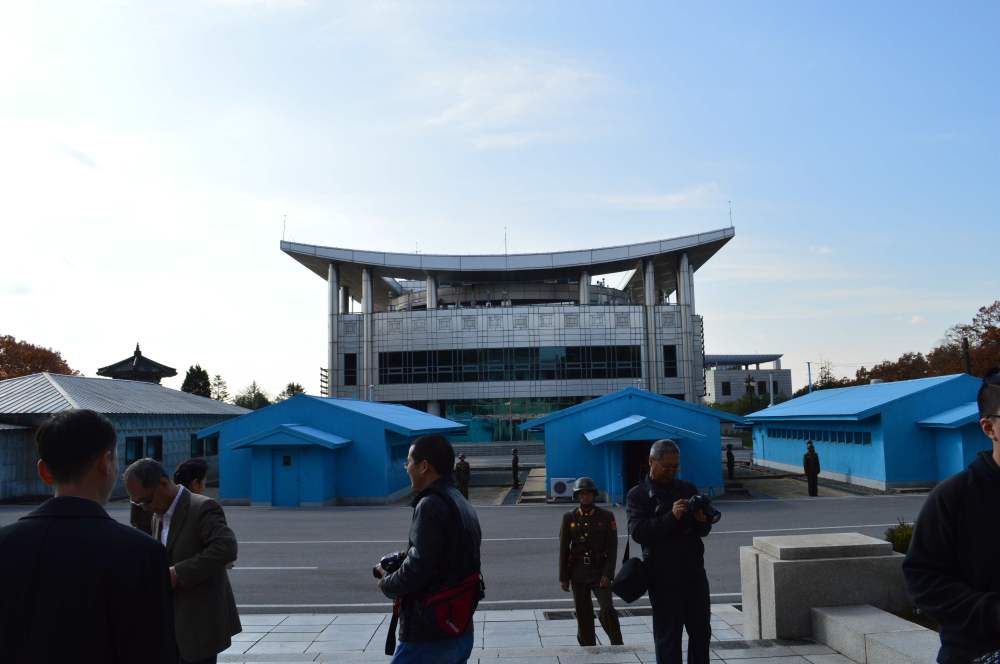
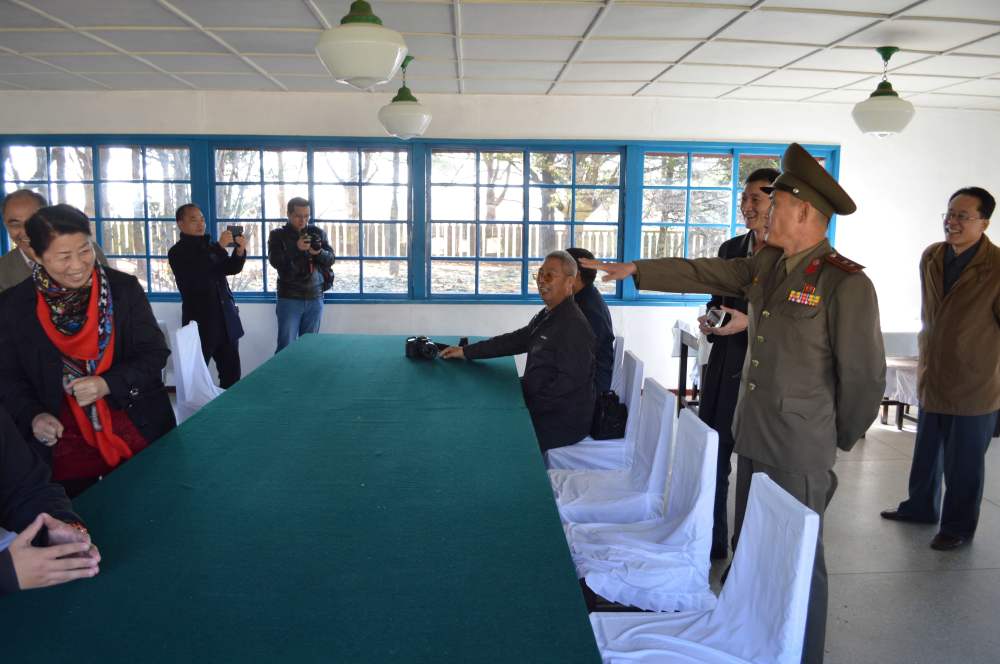


As the tour came to an end, we managed to convince the soldier to take a photo with us before leaving. It was funny to note that the accompanying soldier in the van forgot to salute the checkpoint soldier as we drove past! (I think we were the only ones who noticed as the guides were oblivious to this).
On the way back, we saw the same disturbing sights, as well as several people attempting to hitchhike. As we neared Pyongyang, we noticed several large dump drunks fun to the bring with cabbage (Kimchi!). They were filthy, and farmers simply lay onto of the piles of cabbage as someone drove the truck… so much for health and safety regulations!
One of the guides played us a hit pop song at the time, that was all about… CNC manufacturing!!?! Yes, it was a hit song all about the wonders of CNC manufacturing in the industrial world… It felt like something out of Fritz Lang’s ‘Metropolis’!





Back at the hotel, I ran into a gentleman who was a part of the Bahrain Football Team. He explained the team was there to play a game against North Korea as part of qualification for something (sorry, I know nothing about football/ soccer). Was quite a surprise, though!
That saw the end of day 3, probably the most interesting and fascinating yet.
Day 4
The morning commenced with breakfast, as usual, where we met a lovely Chinese-American man who was in the country to “teach opera singing”… Perhaps. It was soon apparent to us that the Koryo Hotel is the place of choice for diplomats, teachers, military, business people and people on official business. We were informed that tourists usually stay at the lower quality ‘Yanggakdo Hotel’, situated nearby.
We also realised the hotel actually had 3 restaurants serving 3 different kinds of breakfasts for different people. One level was serving Asian breakfasts, only for the guides and locals. The next was a private dining area for groups (in this case, the Bahrain Football Team). Finally there was our restaurant, serving limited Western food for Westerners, as well as a more filling Asian selection for Chinese and North Koreans only.
We were driven a couple hours north to visit a water bottling factory. The factory floor itself was very wide open and featured no lighting, apart from the windows. There was plenty of room around, with only a small space dedicated to the machinery, that buzzed and whooshed, bottling sparkling water. We were given a couple bottles to try, and it was surprisingly tasty. Unlike most sparkling waters in the West, this spring provides naturally sparkling water, meaning it is not artificially carbonated. This leaves perfectly balanced flavours with just the right amount of ‘fizziness’. The environment surrounding the factory was spectacularly beautiful, with orange and yellow deciduous trees, a clean, crisp, cool air, and a serene and quiet ambience.
Nampo Area:


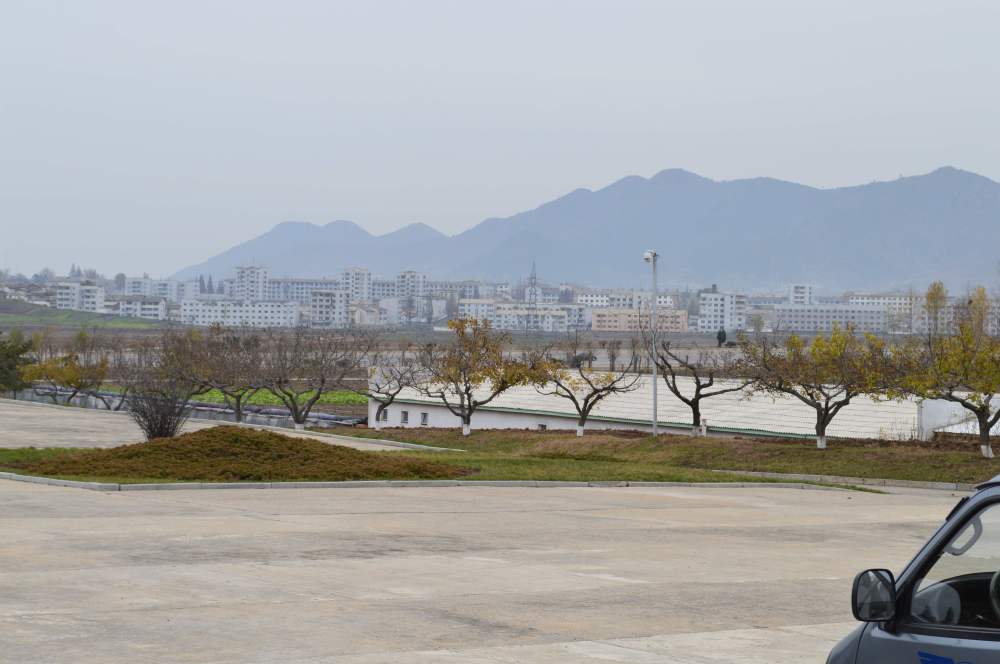

Water bottling plant:





Throughout the tour we came to realise that despite the perils of the nation, it is an unbelievably beautiful place. The air, landscapes and natural environment are just spectacular, and we experienced this time and time again all over the country.
Food is always something people discuss when talking about the DPRK. So, to ‘prove’ they were sufficiently fed, we were taken to a “cooperative farm”. According to Kim and Jung, two types of farms exist: cooperative and state. The latter apparently provides 30% of their produce to the state, whilst the former provides a smaller percentage. I feel that in reality, both simply give 90%-100% of everything to the state. The place was very underdeveloped, and featured limited rice and cabbage crops. As expected, a huge area was devoted to a large bronze monument of President Kim Il Sung and some farmers. We were again made to buy flowers, place them at the foot of statue and all bow to show our respect for the eternal President. The local farm guides were so adamant about the fact that “President Kim Il Sung visited here 2 times… General Kim Jong Il visited here 4 times…” and blah, blah blah… They are so engrossed and blindly devoted to their ridiculous and oppressive leaders that they seem to build a massive monument every time one of these god-like people walk anywhere.
Cooperative farm:



Anger and frustration aside, we were shown to a local kindergarten, where a large group of children started singing loudly and passionately for us. This was one of the more eerie parts of the tour. The children didn’t smile once when we were there, and simply sang as loud as they possibly could, with the lyrics all about Comrade Kim Jong Un and the greatness of the DPRK. It was a frightening glimpse into just how much brainwashing occurs in the state. That said, they were very talented for their age (whether they enjoy it or not).
Kindergarten children performing:



Lunch was up next at a restaurant in Nampo city. Following this, we drove through the Nampo port city and across an 8km wide dam that separates the West Sea of Korea and the Taedong River. It was quite a spectacular feat, and we were shown an incredible documentary about the dam’s construction, which I can only imagine resulted in countless deaths. They were adamant about how it was originally scheduled to take up to 20 years to construct, but “by the miracle of Korea, the soldiers completed it in 5 years”. They highly touted the area as a booming trade hub, permitting all kinds of trade ships to enter the nation. What was not mentioned was that almost every country sanctions all trade with the DPRK, and so marine trade is, in reality, almost non-existent.
West Sea Barrage:


Up next was something I was looking forward to… Rifle shooting in North Korea! We went to a relatively new shooting range where we shot .22 Anschütz rifles. It was quite fun, yet frustrating because of the very frequent power outages, forcing us to stop mid-shoot many times. It all ended well, though… I won a stuffed elephant!
Shooting range:

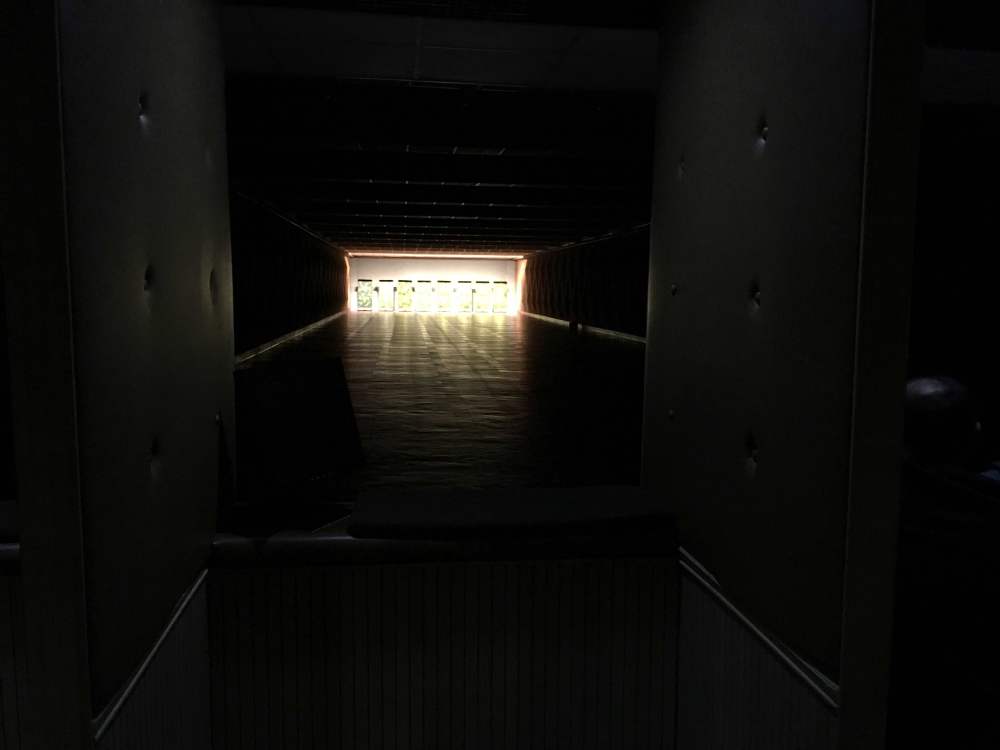

For the first time, on the way back to Pyongyang city, we experienced a traffic jam! There were heaps of cars on the road this evening, and it took quite a while to get to the restaurant for dinner. Now, whether the traffic jam was caused by legitimate overcrowding, or by some other wild factor was unknown.
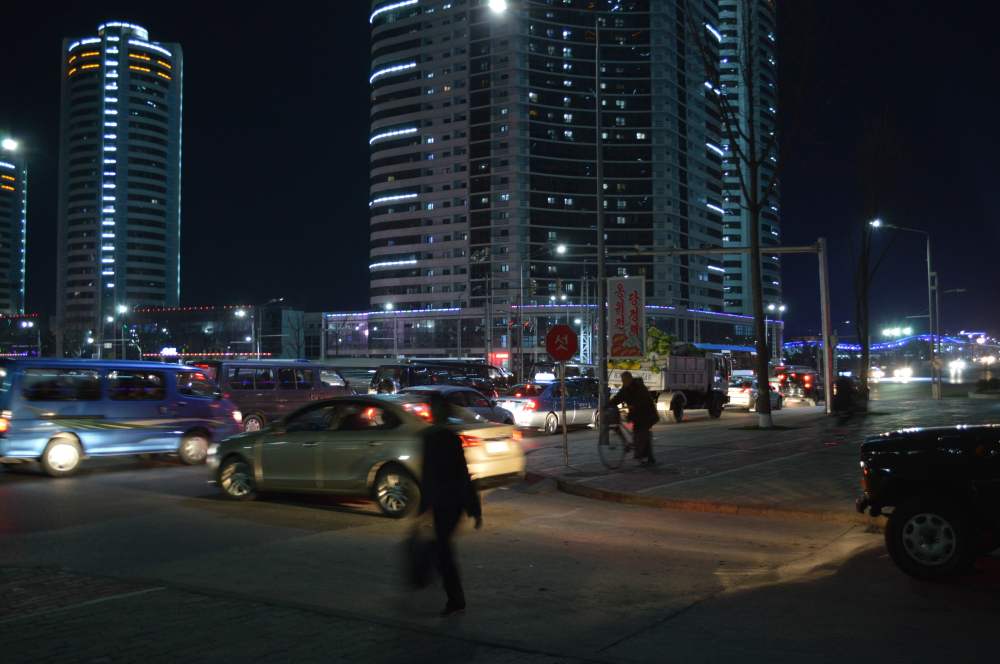
At dinner, we came to properly realise the stark difference between our two guides. Kim, the younger of the two, seemed far less brainwashed, and could actually pass as a normal South Korean! She was far more relaxed about everything, although she was still strict about the cultural practices of the country. Meanwhile, Jung seemed to have been heavily brainwashed. She was stuck in the idea that the DPRK is the greatest country in the world in all ways, and many conversations would be steered to show how the DPRK “does it better”. She definitely seemed like a truly patriotic North Korean.
The experience was getting all the more involved and fascinating, and we were excited for the days to come.
Day 5
Following a rainy night and a quick breakfast, we boarded our trusty old KITC van to head to some museum commemorating some leader. Along the drive in the early morning, we were discussing education within the country. According to Kim and Jung, the largest university is known as Kim Il Sung University. They also told us that our driver (Comrade Jong) attended said university, where he took a course in driving… Yes driving. Honestly, can they not come up with something better?
We arrived at an exhibition area, where we met another local guide who was to show us around the displays. She seemed very friendly and unlike many other local guides. She said that she gave up being an English teacher so as to become a guide and learn more about other countries (because her country doesn’t let normal citizens even think about other countries). We were asked many questions about our home, Australia, and she was eager to learn about our way of life. It was quite an eye-opener, finally meeting someone who clearly has the intellect and drive to do some incredible things in life, but who is hindered and controlled by her government.
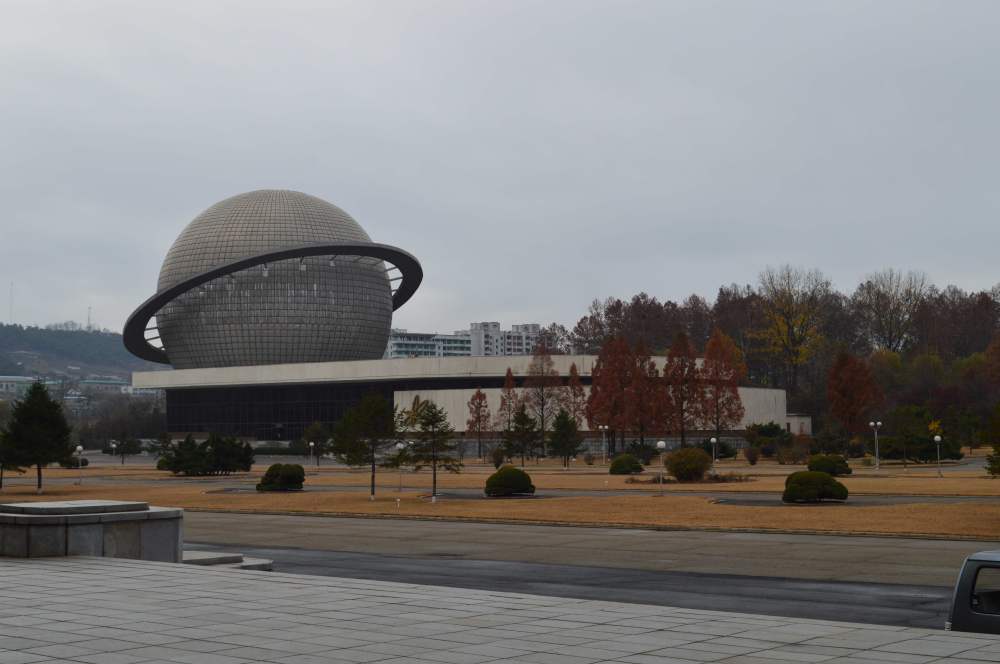
The first stop was at a very large spherical dome that resembled the planet Saturn. We climbed several flights of stairs to reach an exhibition area displaying the accomplishments of the DPRK Space Program. The guide enforced how the country has launched 3 satellites into space, all of which were completely successful on the first launch (yeah, right). There was also a large group of school children at the exhibition, presumably on a school excursion to learn about the space program. This was interesting, as it brought back completely normal memories of similar school excursion in Australia. It was surprising to see how such things do actually occur here in the DPRK.

Before continuing, it’s work noting the state of public restrooms. Firstly, toilet paper is completely non-existent in public. The rest-rooms are filthy and smell absolutely horrible. What’s worse, most of them don’t have any running water. So when it comes to hand-washing, a very large tub is left, filled with ice cold water… A very unhygienic solution (and, obviously, hand soap can not even be imagined).
We then took a drive to a gift exhibition all. This, for me, was the most excruciating and anger-inducing part of the entire trip. We were led through countless rooms filled with shelves and shelves of every object imaginable. There were statues and carvings made of everything thinkable, and in the shape of everything in existence. The wealth of gifts is absolutely phenomenal. These gifts are all things that have been given to the great leaders from either Koreans or other nations. What I could not stand was to listen to our guide talk about the countless carvings and statues, that were produced so intricately from “500 year old trees”, featuring all sorts of animals and monuments. Each one was special in that the number of animals, or the height of the pot, or the circumference of the bowl, or whatever, signified some sort of event or landmark, such as the “birth of the great leader, President Kim Il Sung”. For example, a pot was produced by soldiers, and made to be 216cm tall to signify President Kim Il Sung’s birthday (February 16). Why, oh why does it matter that such a piece is produced with such metaphorical and symbolic value (which in itself if frustrating because of who they are symbolising and praising), only to be placed in an exhibition hall that is almost always deserted and empty. I wouldn’t be surprised if the great leaders have never even glimpsed the pieces. The amount of effort and devotion to producing these things is unbelievable, and it is a terrifying thought that it is all done with the intent of praising those who oppress the population.
The exhibition also featured some surprising items: there was an old Apple iMac, CRT TV’s, flatscreen TV’s, and even MontBlanc pens!
Following lunch at a traditional Korean BBQ restaurant, we went to the Revolutionary Martyr’s Cemetery, an incredible place displaying busts of significant people who had passed away. It was extremely well kept, and was set up on tiers, keeping the most important at the top, including Comrade Kim Jong Suk (President Kim Il Sung’s wife). We passed a new bust that commemorated a person who had passed away just days before we visited. It was astounding that a whole new bust and concrete platform had been produced so fast.
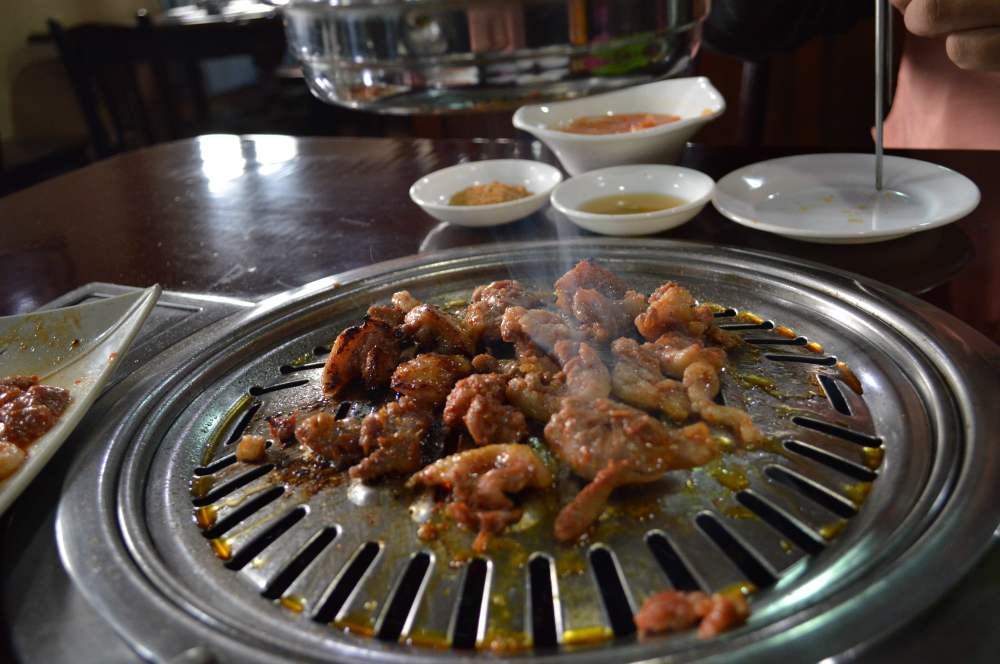
Revolutionary Martyrs’ Cemetery:
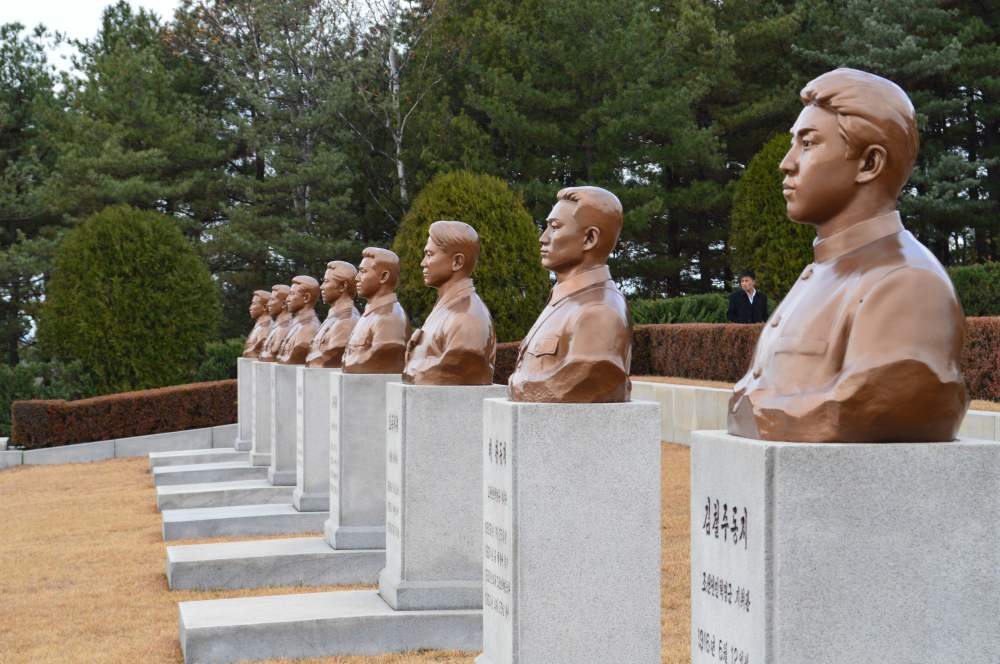

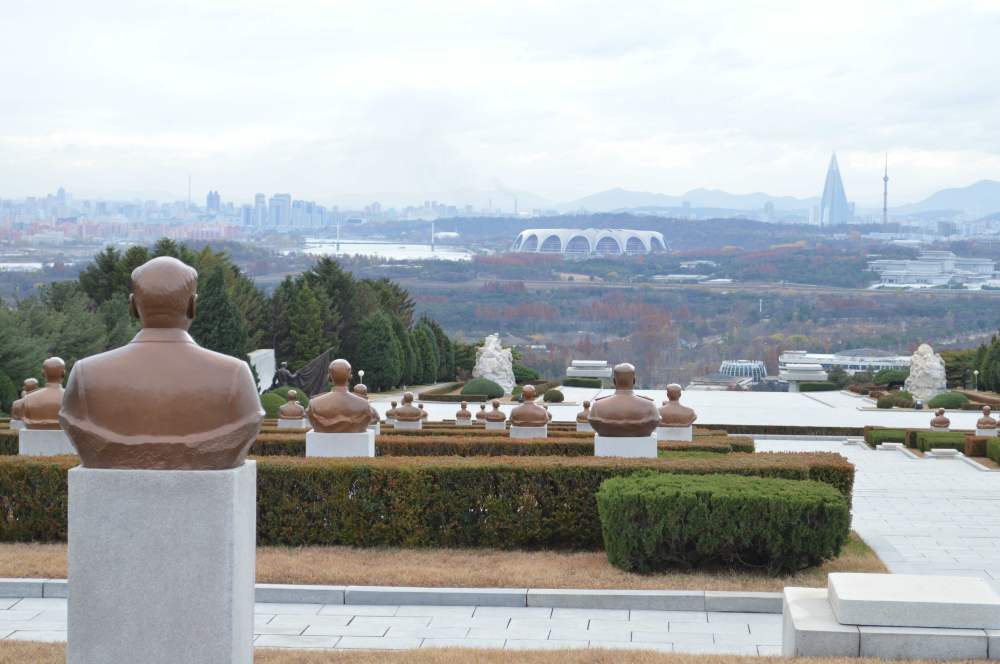
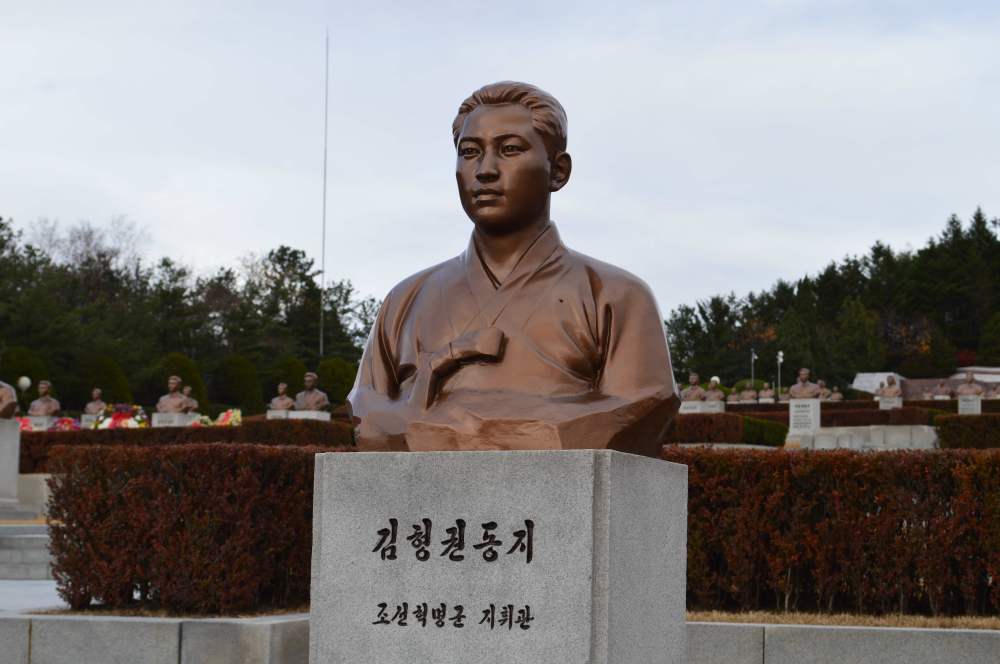



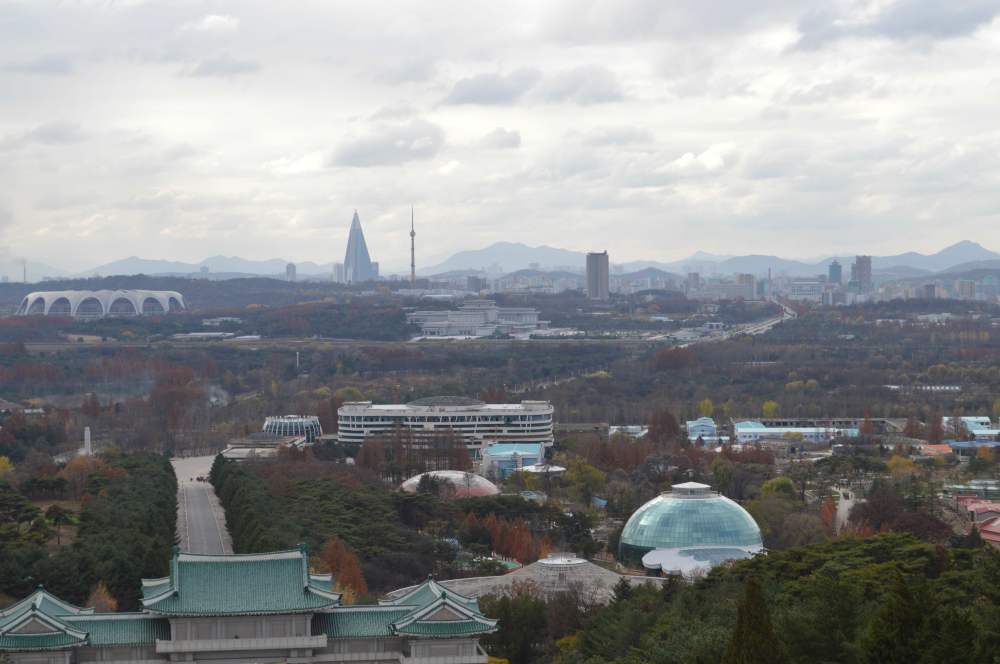
We then visited one of Pyongyang’s ‘funfairs’. It was essentially a theme park, with rollercoasters and rides that had not been maintained at all since 1970. Everything was so old, so historic and so vintage, almost to a nostalgic level. Riding one of their rollercoasters was one of the most terrifying things I had done, purely because I was so worried about the ride’s maintenance and safety standards, which were virtually non-existent. It was interesting, also, to see so many people at the funfair dressed in military uniform. Uniformed soldiers playing on bumper cars and all sorts of funfair rides made for quite a unique and hilarious sight.
Pyongyang funfair:


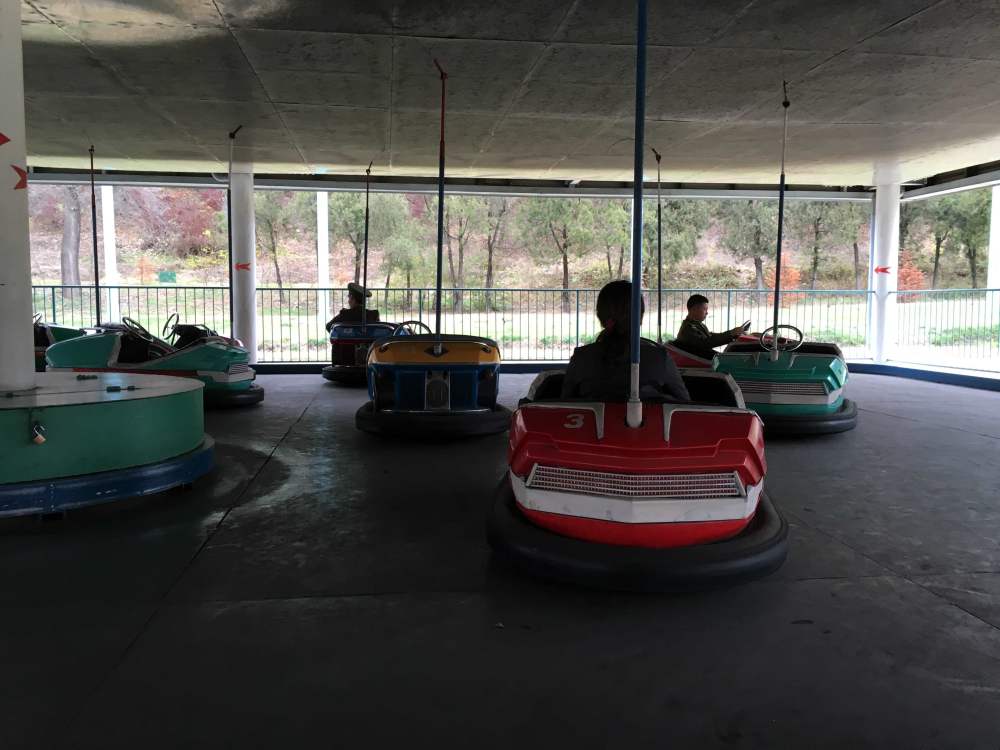
In the evening we went to the Pyongyang Gold Lane bowling alley, which also had not been touched since 1970. Very old computer systems were installed to keep score, and the entire place was terribly dated. The systems were so poor that it would frequently mistake the number of pins that had fallen. Just like any other bowling alley, drinks were available, and we somehow managed to get hold of cans of Sprite, brought in from Vietnam! Very strange…
What was astounding, however, was to see so many normal North Koreans having fun and enjoying a night out. It was certainly something we didn’t expect, and seemed too true to be staged by the government.
Pyongyang Gold Lane Bowling:



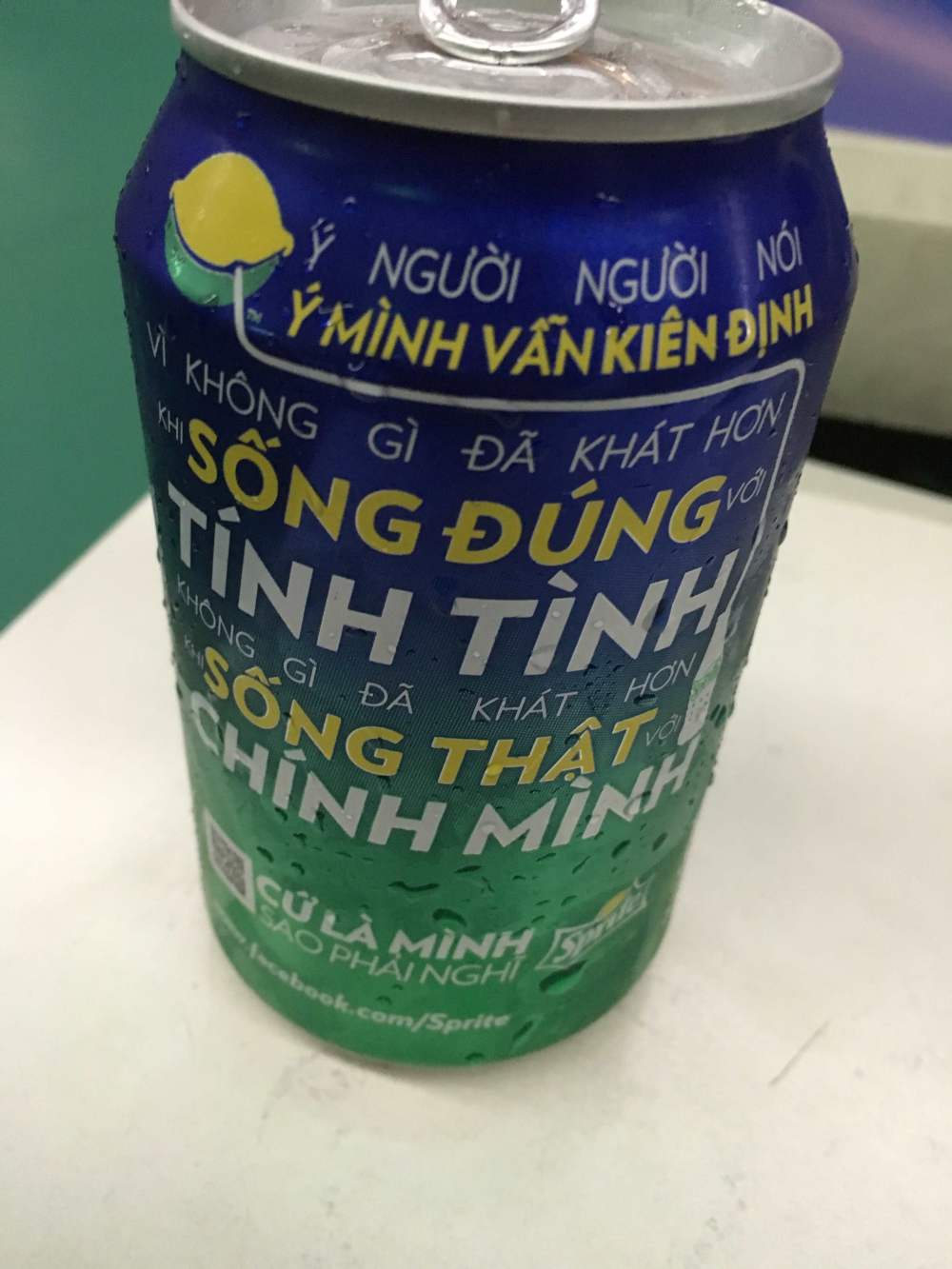
Following a quick stop at another night funfair (which was mostly out of action due to power failures stopping all the rides), we had dinner at a famous cold-noodle restaurant. It was interesting to discover that the cold-noodles have a special place in Korean culture. When a couple gets married, they will traditionally serve cold noodles at the wedding. Hence, people ask “When are they serving cold noodles?” to ask what we would say as, “When are they tying the knot?” Fascinating!

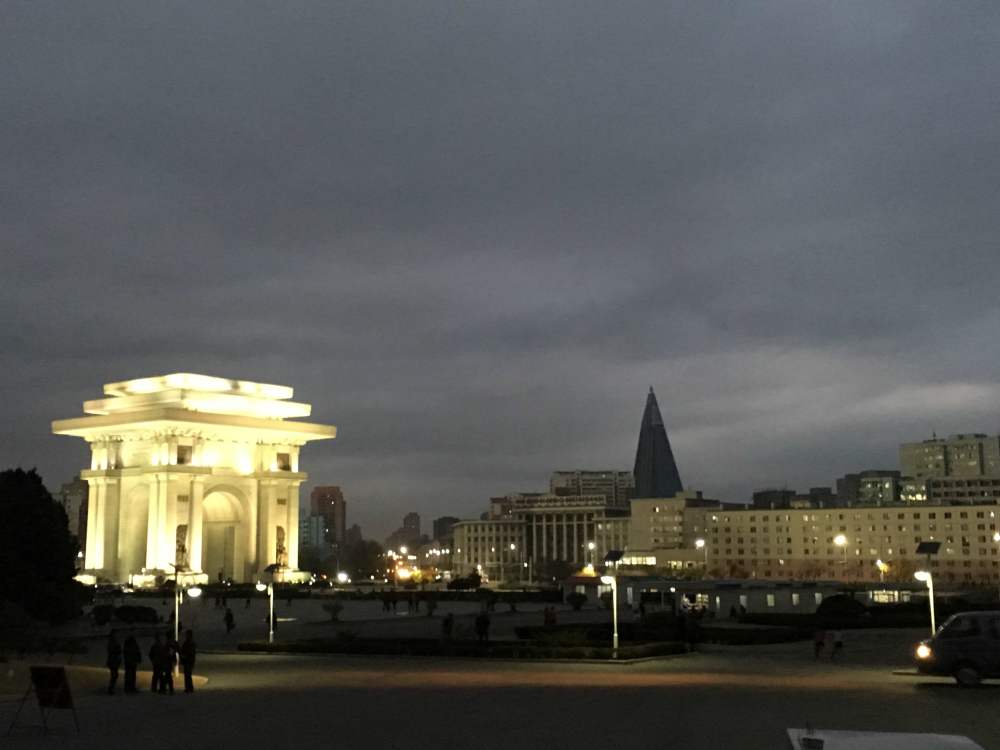
This was our final night in Pyongyang, as we were to head to the mountains the next day for our final night in the country.
Day 6
This morning we bid farewell to the Pyongyang Koryo hotel and set out on a drive up north to the Mt Myohyang area. Along the way, we witnessed the usual sights in the North Korean countryside, as discussed earlier: child labour, poverty, military and people struggling in many ways. We also passed the first and only form of advertising in the city. There was a large billboard aside the road that advertised the local North Korean car manufacturer. Apart from this, there was not a single bit of advertising anywhere in the country (because everything is owned by the state and individual businesses simply don’t exist)… No graffiti, no posters, no TV ads, no billboards, nothing. Perhaps the ad is there purely for foreigners to see a normal side of the country.
Before arriving at the hotel, we visited yet another gift exhibition hall, housing countless opulent and intricate gifts. What stood out was a glass ash tray and a poorly written note on a coffee-stained piece of paper, presented and signed by President Jimmy Carter. It was apparent that no thought went into the gift whatsoever, and is a perfect representation of just how much the US cares about the DPRK.
We were shown into a massive room that housed an actual aircraft. It was gifted to the DPRK by Russia, and was clearly an old and historic piece that seems to have never been used. We asked the guides how they managed to get the plane into the building, and they responded with, “By the miracle of Korea”. Hmmm…
Views from the gift exhibition hall area:
I’d love to share photos of the exhibition halls, but this was an area where photography was strictly prohibited for some reason. This particular hall exhibited gifts from all over the world, with cabinets and shelves arranged by country and continent. It was so surprising to see just how many countries are presenting things to the nation. Australia even had its own corner, with many presented by the original Communist Party of Australia, including a large traditional Aboriginal dot-painting of General Kim Jong Il and the DPRK flag.
The next stop was a historic Buddhist temple, the first and only sign of religion we saw on our visit. It had incredibly fresh and clean air, thanks to the pine trees, and we were told that extended time there would make you “10 years younger”. The guides there were very repetitive about how it is such a peaceful place, yet many things were damaged or destroyed by US bombs during the war.
Buddhist Temple:
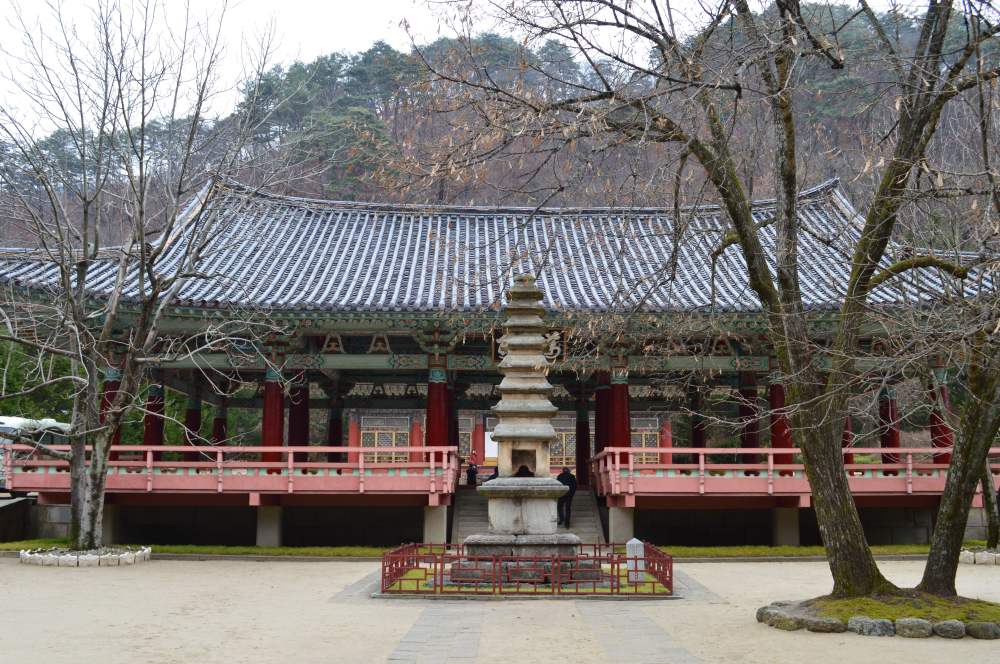

We finally arrived at the opulent Hyangsan Hotel, which the guides classify as a “7-star hotel”. It is worlds better than the Pyongyang Koryo Hotel, however, not even close to 7-stars by Western standards. A full review of the hotel can be found here.


In the afternoon, we took a walk up the mountains with our guides, where we witnessed absolutely breathtaking scenery. This was yet again a time where we realised just how spectacular and beautiful the country is, despite the internal struggles. I also took it as an opportunity to ask Jung about the DPRK political systems. According to her, they have a democratic system that seemingly works like the Westminster system. There are elections per district, and then at a higher federal level. There are also three parties at the top level. She informed me that the biggest and most successful is the Workers’ Party (with Marshal Kim Jong Un as the leader). They have been in power since they were founded by President Kim Il Sung. I do wonder whether or not they actually believe this system is pure and honest. Do they even have elections, or is this just what they tell us? Do they realise that everything is so corrupt that elections are useless? Or is it the case that the population is so brainwashed and so terrified that they will simply always vote to continue the Kim dynasty? Who knows…. Jung was also adamant about the fact that they give anyone the chance to become leaders, whilst the ‘US imperialists’ only let the rich and famous be leaders (ok, the latter part is true, I guess).
Views during a mountain climb:
It was the final night in the DPRK, and we had had an absolutely incredible time. We finished off the evening with a round of pool with our guides in the hotel’s recreation area, before heading to bed and departing to Beijing the next day.
Day 7
The final day had arrived, and after a breakfast that was quite a bit more substantial than the Koryo Hotel, we checked out of the hotel, took a photo with the guides and driver and began the drive back to Pyongyang. We passed several military checkpoints along the way, where salutes and ID documents where exchanged.
The guides told us today was their equivalent of “Mothers’ Day”, which is treated as some massive national holiday. In Pyongyang city, the streets and restaurants were full and crowded because of all the citizens out for the day. We went to another famous cold noodle restaurant for our last DPRK meal. Surprisingly, the place was full of North Koreans, and for the first time, we saw a relatively large/ obese man. In a country ridden with poverty and malnutrition, we had not seen a single large person, as absolutely everyone was incredibly skinny. In the restaurant, however, we saw one man, dressed in a formal suit similar to those worn by the Marshal Kim Jong Un. He was there with a large family, all dressed in formal and expensive-looking clothes. Perhaps he was a high ranking military or government official, and it just goes to show how much better off the military/ government are.
As we had time before the flight, we went back to the Koryo Hotel for a round of pool. During the game we saw a local outside on the ground, seemingly very, very drunk. It was unclear what was happening, and people started crowding around the person. Kim said he/ she was “just drunk”, but who knows. The person was moved away pretty quickly.
As we departed to the airport, we were given back our passports and visas (which the guides had held during our stay), and also given very old-style, paper Air China tickets for the flight back.

I will leave the words of sentiment and wisdom for a reflective post later on, but I do hope that you have enjoyed this glimpse into one of the most feared and unpredictable nations in the world. Please do let me know if there are any questions about anything at all, and I’ll do my utmost to respond.









































Hi Ashan, nice to meet you yesterday. Very well written description of your trip; interesting to read. Thanks for sharing!
LikeLike
Thanks, Tom! Glad you liked it.
LikeLike